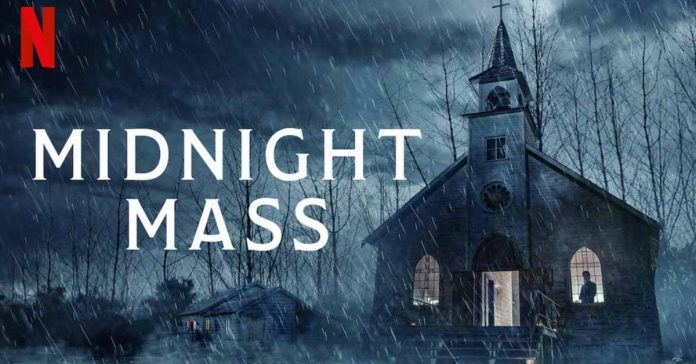Just when you think Mike Flanagan’s shows couldn’t get any better, Midnight Mass strikes the nail through the heart – or should I say, the cross.
The TV horror genre has rapidly developed over the years, swerving from otherworldly demons (Buffy the Vampire Slayer) to final girls (American Horror Story) to satanism (Chilling Adventures of Sabrina). However, it’s the work of Mike Flanagan that continuously serves as a compelling watch. Having established a strong presence in the genre with the Netflix originals The Haunting of Hill House and The Haunting of Bly Manor, Flanagan is consistently subverting what can be defined as ‘horror’. Hill House brought a multitude of ghosts, Bly Manor added gothic romance, and now Midnight Mass fuses Catholicism with a disturbing twist and many a poetic monologue.
The story of Midnight Mass, like many in this genre, begins with an isolated community – this one residing on Crockett Island. Situated off the coast of New England, the ‘crock pot’ has a mere population of 127 and is subdued by its dingy skies and a tragic oil spill that has deprived the fishing town of any economic gain. In its time of most desperate need, two characters return to the island: ex-convict Riley Flynn (Zach Gilford), and a new mysterious priest, Father Paul (Hamish Linklater), who hopes to rejuvenate the town and bring about ‘miracles’ after their last priest fell ill in the Holy Lands. Already, some keen-eyed horror fans may have noticed the show itself is an Easter egg, having appeared as the title of a book written by Kate Siegel’s character in Hush (2016) and then later mentioned in Gerald’s Game (2017). It has been years in the making and the standard of the show completely mirrors this.
Source: Netflix
At first, the island appears as normal as a withering community can. Two ferries connect to the mainland, allowing Riley to attend his check-up meetings after a harrowing incident of drink driving four years ago, while the island’s inhabitants move to and fro. The mayor’s daughter, Leeza (Annarah Cymone), is one of the few attendants of communion in the rickety church, St Patrick’s. The kind-hearted Sheriff Hassan (Rahul Kohli) tries to govern the small town while facing off against some extremist views—aka the despicable Bev Keane (Samantha Sloyan)—after joining their tight-knit community as a practicing Muslim. Only allowed a small office in the back of the grocery store, he witnesses marginal crimes at most. Riley’s childhood sweetheart, Erin Greene (Kate Siegel), struggles with her identity after living in her mother’s shadow throughout her life and now replacing her as the schoolteacher, on top of being eight months pregnant.
Source: Netflix
Where Flanagan truly shines is in his ability to create characters with psychological depth and real believability – cheap jump-scare horror is not found in his shows. The focus of Midnight Mass is on ambiguity and across just over seven hours it is consistently dedicated to leaving unanswered questions for the viewer’s interpretation, mostly through monologues of character’s retrospections and reflections on their struggles:
Riley’s quest for redemption.
Hassan’s powerful speech about being a Muslim sheriff.
Erin’s conversation about life and death.
Even if the show doesn’t interest you, I’d recommend everyone to watch the last monologue (featured in episode seven) as it is poignant and beautiful, especially as it is paired with the Newton Brothers’ soundtrack.
Source: Netflix
Just like Taylor Swift with her infamous ‘Track 5s’, Flanagan has mastered the impact of his ‘episode 5s’ as being the most devastating episodes of their prospective shows. The ending of ‘Book V: Gospel’ is the catalyst to the show’s major twist, and is almost as impeccable as arguably one of the best episodes of TV in Hill House’s ‘The Bent Neck-Lady’. Whilst some viewers may argue that the slow pace of the primary episodes makes it hard to endure till this point, the true dread lies in the realisations about humanity rather than the disturbing supernatural climax. Is the church a place of comfort? Are we too literally following religion? Why is manipulation so dangerous?
Flanagan has previously stated that Midnight Mass is his favourite project to this day for this reason, as it incorporates his religious past as an altar boy and his struggles with faith. Of the seven episodes, each title refers to a book in the Bible, with the first four concentrating around the Old Testament and the last three moving to the New Testament. Whilst the premise of each episode would be easier to understand for those with prior religious knowledge, this is not necessary as the plot is still very immersive, and is particularly interesting to someone of an atheist background. It could also be said that religion is not the protagonist of the show but merely a side character and that indoctrination, death, addiction, and morality are the scene-stealers captivating the viewer in a story that weighs as a commentary on humanity itself.
The Verdict
Midnight Mass certainly isn’t a cheap budget horror story to pass the time on Halloween, and you certainly won’t find brutal stabbings and jump scares within its scenes. Instead, its lasting sermon will ensnare your mind as you wait, filled with dread, to see the fate of Crockett Island.
“Remember you are dust, and to dust, you shall return”.
Words by Emilia Butcher-Marroqui
Support The Indiependent
We’re trying to raise £200 a month to help cover our operational costs. This includes our ‘Writer of the Month’ awards, where we recognise the amazing work produced by our contributor team. If you’ve enjoyed reading our site, we’d really appreciate it if you could donate to The Indiependent. Whether you can give £1 or £10, you’d be making a huge difference to our small team.
